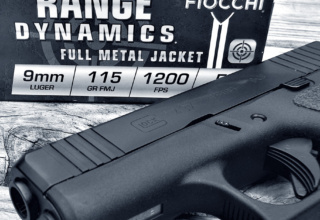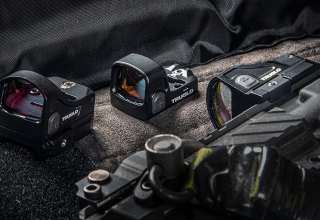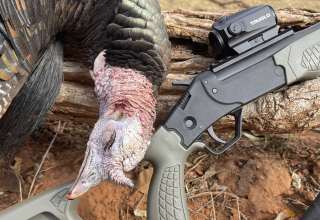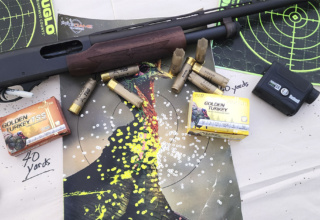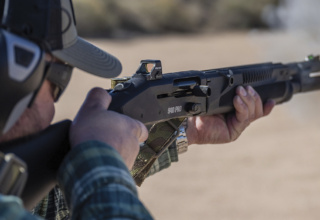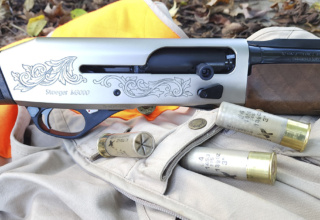Our resident shotgun guru takes on the TRUGLO Double Threat Dove Choke
by Larry Case
The early September sun was hotter than a two-dollar pistol. I sweated my way through the narrow passageway around the cornfield, the rough leaves on the cornstalks taking tiny bits of my hide. The dove shooting would be better, I thought, if the corn had been chopped, but there were some birds around. A pair of doves exploded off the ground in front of me and seemingly broke the sound barrier as they made their escape. I fumbled to mount the shotgun and proceed to blow two tightly choked holes in their wake. Wrong choke for the range and the doves vacated the premises laughing all the way.
One Choke Ain’t Enough!
If you have done much dove hunting, you have been there. The mourning dove enjoys the reputation as a speedster in the game bird world. I have often watched from my post on a dove field while others blazed away at a bird that appeared to be a Bayer aspirin shot out of a .257 Roberts. Not only are they fast, but doves have a quirky, erratic flight that seems to defy your shot pattern. For a shotgunner to be successful on doves, everything needs to be right—gun fit, stance and positioning to the shot, lead and follow through, and the correct choke.
One problem with the choke issue in dove shooting, as in most shotgun situations, is that we don’t confront the bird at the same yardage all the time. During a day in the dove field, it is common to be presented with doves passing your stand at the optimum range for your shotgun. If you have doves coming into decoys or flushing out of nearby cover, you may need a more open pattern, and these changes can occur very quickly. You can carry around a bag of screw-in chokes, and I have done it, but taking out one choke and installing another in the field doesn’t really work that well. It’s a little time-consuming and cumbersome and you will probably end up leaving one choke selection in place and making do with whatever is in the gun.
An Even Pattern, Close and Far
Shotgun chokes give us a pattern (the distribution of the shot pellets within a defined area) at a specified range. Not so many years ago, how a shotgun patterned was usually determined on paper within a 30-inch circle. It is unclear who came up with this measurement, but most agreed it was as good a way as any to measure what the pattern would look like at a certain range. Common consensus said that if the gun, shell, and choke combination delivered an even pattern of pellets within this 30-inch circle at a realistic range for game birds, usually about 35 yards, this was sufficient to take birds consistently.
Remember, this reasoning came before the current trend in the turkey hunting world of tighter and tighter chokes, lead shotshells designated for turkey hunting, Tungsten Super Shot (TSS), and other things specific to the gobbler-hunting realm. Most of the time in turkey hunting, we are sitting and aiming at a hopefully stationary target—the turkey’s head and neck. Turkey hunters wanted very dense patterns for this relatively small area (ten-inch circle) for clean kills at sometimes extreme ranges.
This is quite different from what we are doing on the dove field. The idea of the 30-inch circle pattern is to give us an even pattern of pellets to direct at the gray rockets as they streak by us under the hot September sun. In wing-shooting, we are not aiming, we are moving the gun ahead of a moving target. We are, in fact, “shooting where they ain’t.”
What if we had a choke option that quickly and easily adjusted to different ranges? Enter the TRUGLO Double Threat Dove Dual Position Choke.
“As a Texas company, we love dove hunting. This choke tube gives hunters more options in the field and adapts to changing conditions through the hunt,” said Pliny Gale, TRUGLO Product Marketing Manager. “We’d rather spend our time bagging birds than changing choke tubes, or wishing we had another choke option on the gun instead of in the truck.”
This choke tube is as simple as it is handy. The concept is this: one position on the tube for “decoy” or closer shots (wider pattern) and another position for “passing” for those high flyers speeding by you over the dove field. One choke, two positions, change with a simple twist of the tube. I can change from the passing mode down to the decoy position when I leave my stand to go look for a downed dove and I know some of those explosive flushes are going to happen right in front of me.
Where the Rubber Meets the Road
I shot the Double Threat Dove Choke on the aforementioned 30-inch circle and got an even pattern within that area—more than enough to do a good job on doves. This test was done with Federal target ammo, #7 ½ shot. (TRUGLO recommends the Double Threat Dove Choke be used with #6 to #8 size shot.) These shots were taken at 25 and 35 yards, which are good representations for the two yardages, “decoy” and “passing.” Equally good pattern distribution was seen at both distances.
Over 100 rounds were fired through the Double Threat Dove Choke at clay targets on the trap and skeet range. This was done with a variety of shotgun ammo—Browning, Aguila, Federal, and Winchester. We saw no malfunctions of any kind with the choke, and it seemed to disperse equally among the different brands.
On examining the Double Threat Dove Choke, you will observe a CNC-machined (computer programmed, tight tolerances) choke tube. I had no problem taking off the choke tube currently on the gun, a Remington V3 Field Sport model, and installing the TRUGLO Dove Choke. The choke is supplied with a simple spanner wrench to tighten the tube on the gun. Once the choke tube is installed, the choke is adjusted from one setting to another by hand. Easy peasey.
When dove season opens in September, I will be in the dove field with the TRUGLO Double Threat Dove Choke on the V3 Remington. I may not hit them all, but I bet they don’t laugh as much this year.






